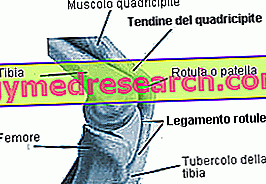The march is a "basic" discipline of athletics, since it is carried out on 20km and 50km Olympic road distances.
Pitch technique and analysis
The technique of the march is regulated by the IAAF rules:
Athletic walking is a progression of steps taken so that the athlete maintains contact with the ground without visible loss of contact. The advancing leg must be stretched starting from the first contact with the ground until the moment the leg is in the vertical position.
The movements of the march are primary and secondary; the primaries are those of the legs designed for the translocation of the body and the secondary ones of the trunk and arms, designed to compensate for the movement of the lower limbs.
The pace of athletics can be broken down and analyzed as follows:
- Single support: in the support, the leg in contact with the ground must be completely stretched from the moment of contact of the heel to the push on the forefoot; in this way, the supporting limb is placed in an oblique position avoiding an excessive raising of the center of gravity
- Double support: it is the moment in which the feet are in contact with the ground, it goes from the heel of the front foot to the sole of the back foot and determines the length of the step; in this phase, tracing a hypothetical line that divides the body into two parts, you should see a greater angle of thrust of the rear leg with respect to the angle of the front leg, allowing a longer thrust phase and less braking at the time of attack.
- Thrust: starts from the moment in which the projection to the ground of the center of gravity goes beyond the base of support and ends when the foot leaves the ground. NB : the thrust must not be dispersed upwards but should concentrate more towards the front; furthermore, it must develop for as long as possible. Looking sideways, the walker is seen as the leg being TESA back and absolutely NOT with a bent knee.

- Oscillating phase and attack: after the push, the foot and the leg must be projected immediately forward, with the foot that touches the ground, placed horizontally and parallel to the ground; at the end of the action, the leg is extended and makes contact with the ground through the fully erected limb heel. The approach of the sole of the foot to the ground must be gradual (called "rolled")
- Action of the hips: the movement of the hips characterizes the movement of the march and is necessary to eliminate the excessive raising and lowering from the center of gravity with each step; in all movements, the hips perform a circular action of 360 ° which determines the fluidity and cost-effectiveness of the walking pace
- Actions of the trunk and upper limbs: the upper part of the trunk is slightly forward in the thrust phase and vertical during the single support; laterally, it always follows the movements of the hips with small oscillations. The use of the arms is said to balance, they move in a flexed attitude with FIXED angle of the elbow equal to 90 °. The movement must be synchronous and broad to give fluidity and harmony to the step.
Training of the march in athletics
The two areas or areas for which it is necessary to choose carefully the means of training are the AEROBIC RESISTANCE and the AEROBIC POWER .
Aerobic endurance is sought in order to build the athletic base, to regenerate or facilitate recovery and to lay the foundations for preparatory training for aerobic power sessions. The aerobic power, on the other hand, is stimulated for the search for the best race pace, therefore to favor the conquest of the greatest specific resistance; obviously, the two areas (or capacities) are closely related to each other.
As with other sports, the area of resistance (or aerobic capacity) is more extensive (quantitative), while the area of power is intensive (qualitative); it follows that the young sportsman DEBBA favors extensive and quantitative work, while the elite athlete needs more specificity and training intensity. The extensive work at a young age also has the function of mentally accustoming the athlete to constant and prolonged work volumes; on the contrary, for the advanced sportsman, marching at an intensity lower than 25-30% of the anaerobic threshold (SA) or deflection value (vd - see Conconi test) has NO meaning except that of heating, recovery or regeneration and deaffaticamento. After all, it is necessary to take into consideration that: working for large periods at intensities far from the SA determines (inexorably) a lowering of the latter as well as a greater psychological difficulty in restoring this speed of execution. However, this is a very important "slice" of athletic preparation (especially in the heating and discharge functions) which must NEVER be eliminated, even in conditions of limited time.
Reasons and ways to refer to race speed in choosing the training intensity of the march in athletics
First of all, let's specify that setting the race speed as a reference for the calculation of training intensity does not exclude considering it as a stage of arrival in the training project! With the aim of conquering a certain speed through the annual training, it certainly cannot be considered "literally" this parameter in the calculation formulas for the first training period; a completely inapplicable table would result. However, thanks to the experience of observer and analytical technicians, it was possible to gain the certainty that: the competition pace of the walker is ALWAYS 7% lower than the SA (in metric terms, the difference between speed in SA and speed of competition is about 700-1000m / h); this is a fundamental datum since, even if it is not possible to predict a REAL race speed without resorting to a maximal test (absolutely UNBEARNING), it remains the possibility to carry out a specific test for the calculation of the vd on which to establish first the THEORETICAL speed of COMPETITION and then the intensity of training (based on the period and the objective). NB . The concentration of lactate detectable on athletes engaged in the various distances of travel is approximately 2mmol for 50km and between 3.3 / 3.8mmol for 20km.
Training of aerobic endurance in walking: training means
Slow running: it has an introductory, deaffatic and regeneration function; it should be performed in a quiet heartbeat condition and is essential to constitute the general resistance of young athletes. During the slow journey attention is paid to the technical gesture and less to the amplitude / frequency of the step. It is a type of slow work at a constant pace, with an intensity between 75-80% of the race speed, about 10-15km long in the 20ists and 15-20km for the 50ists.
Marching over long distances: essential for adapting the osteo-articular apparatus, tendon and muscle structures; it is the most suitable medium for the extensive development of the walker and has an essential role in psychological development. It is a type of work that can be carried out:
- long and constant
- long and in progression
- long with long, medium and short rhythm variations
It has a rhythm between 80 and 85% of the race speed, 20-40km long for the 20isti and 35-55km for the 50isti.
March at a slow pace - medium: it is important for the technical aspect, it takes place at 85-90% of the race speed in a constant manner and is 10-20km long for the 20ists and 10-25km for the 50ists.
March at medium pace: it is the connection between resistance exercises and aerobic power exercises. It requires a relative physical commitment but ALWAYS a high concentration and is very useful as it requires very short recoveries. It is an average job and can be performed at a constant pace, medium in progression, medium with long, medium and short rhythm variations, repeated long and short; it takes place between 90-95% of the race speed and is 15-25km long for the 20isti and 20-35km for the 50isti.
Training of aerobic power in the march: training means
Race at race pace or higher speed: serves to raise the SA and to accustom the muscles to lactate concentrations even higher than 4mmol / l while maintaining a certain technical clarity; it is a DECISIVE feature for high performance in the race. This is a work that can be practiced at a tender but constant pace, at race pace but progressively, at race pace with medium and short rhythm variations, and with repeated long - medium - short; the pace is roughly between 95-105% of the race and is 10-25km long for the 20ists and 10-30km for the 50ists.
Muscular work: it is a work in the gym, in the form of circuits with overloads, which will have to orient itself to develop: dexterity, some forms of ability and (with overloads) resistance to force; everything must be integrated with proprioceptive, postural and muscular stretching exercises - joint mobility.
Driving uphill: unlike the previous method for muscular work, this is a specific type; slope and distance must be correlated and regulated but without exceeding the slope which would negatively affect the technical gesture. The function is to increase the resisting force and train for the recruitment of all the muscle fibers, also increasing the aerobic resistance through the CONTINUOUS march, or the aerobic power through the long REPEATED march; with the short REPEATED gear you try to increase the special resistance. NB : Uphill work requires the transformation of the gesture on the plane. The 20ists work about 10-15km while the 50ists arrive at 10-20km.
Training of special resistance in the march: training means
Enter the stage closest to the race (6-8 weeks before); it focuses on extensive aerobic power if the athlete has a high, or intensive, anaerobic threshold if the athlete is characterized by a high degree of resistance. It is therefore essential to learn to know the speed of travel to improve one or the other capacity.
For the special extensive resistance can be used repeated long - medium to race rhythm or slightly lower speed, eg: 2 x 5000 with recovery 1000m or 3 x 3000m with recovery 1000m or 5 x 2000m with recovery 1000m (20isti); other eg: 5 x 5000 with recovery 1000m or 7 x 3000m with recovery 1000m or 9 x 2000m with recovery 1000m (50isti).
For the special intensive resistance can be used repeated medium - short at race speed or slightly higher, for example: 4 x 2000 with recovery 1000m, or 8 x 1000m with recovery 500m or 15 x 500m with recovery 200m (20isti); other eg: 6 x 2000 with recovery 1000m or 15 x 1000m with recovery 500m (50isti).
For the special block, on the other hand, work can be carried out at a tender pace or slightly lower in the 2 daily sessions for a total of 15 + 20km at 95% of the race rhythm (20ists) and 20 + 20km at 95% of the race rhythm (50hours).
The special work consists of marching at a race pace for 25-35km (for the 50th); the ascent with short repetitions takes place by marching on steep climbs for 100-200m for a total of 3-5km (for the 20ists).
Complementary means
These are techniques and training methods that perfect the athletic gesture and improve the performance of the walker:
- Increased muscle efficiency: in the march there are muscles called "limiting", that is the most responsible for producing lactate which, if properly trained, allow to increase the effectiveness of the step. Furthermore, the walker's muscles must withstand two totally different resistances: the push of the step and the BLOCK of the movement, useful in the respect of the Regulation; the walker's muscles must therefore be strong and resistant and, to obtain this kind of performance, it is necessary to carry out exercises of a general and specific nature
- Articular mobility: the walker MUST have an articular mobility ability out of the ordinary and this develops essentially with exercises of general mobility and specific mobility for the march
- Driving technique: they are placed in dedicated training sessions, with distances of 200-400m, in which execution errors must be identified and IMMEDIATELY corrected.
Organization of training in the march
Training must be cycled in the 7 days of the week, within which loads and intensity discharges will follow, modulating both the volume and the density of the effort. The periodization of the march includes the "transition" phase at the end of October and the recovery with the beginning of November; the year is divided into 3 different periods: general preparatory, fundamental preparatory, special preparatory. The most important race is usually placed in August, therefore in the months of April-May some high-level competitions are organized (end of the first special preparatory period); a short period of regeneration will follow and immediately after the resumption of training for the main race.
Bibliography:
- The track and field coach's manual - Part one: general information, races and march - Studies and Research Center - pag. 7:19 ..



